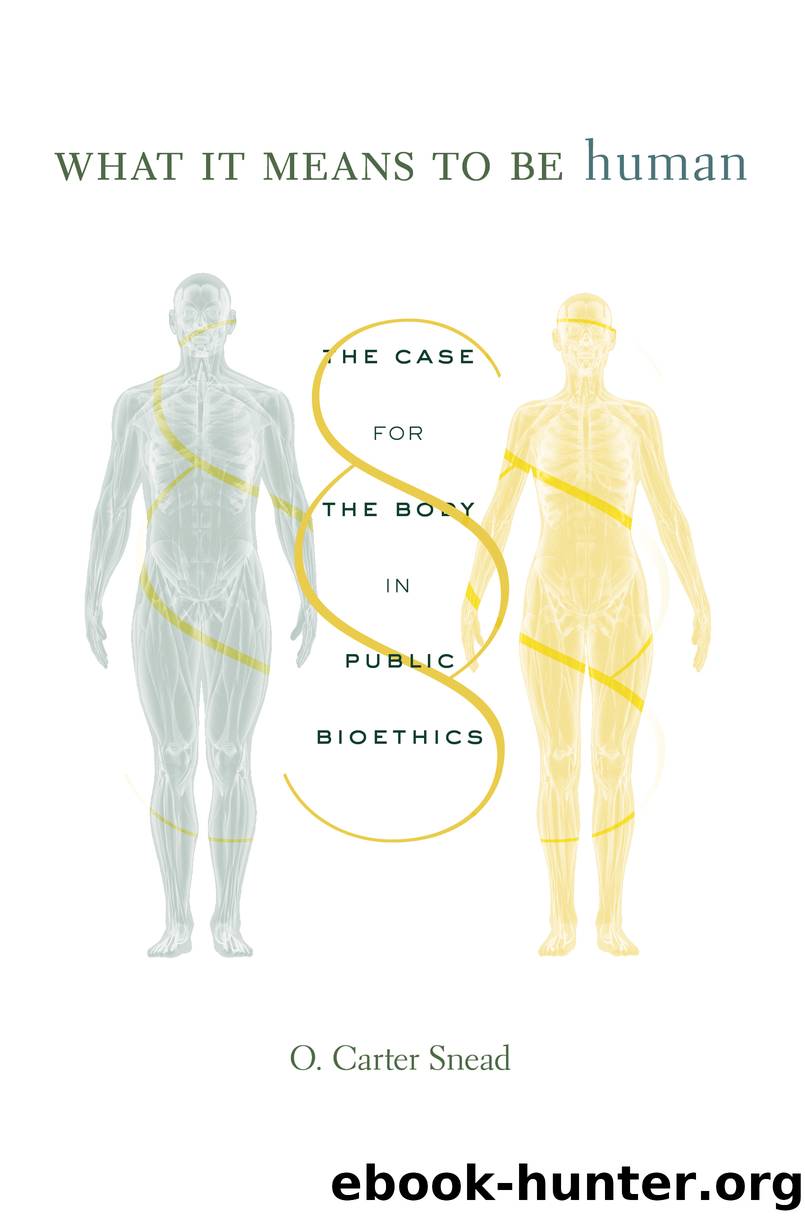What It Means to Be Human by O. Carter Snead

Author:O. Carter Snead
Language: eng
Format: epub
Publisher: Harvard University Press
THE LAW OF ABORTION IN AMERICA
These six Supreme Court precedents constitute the fundamental law regarding abortion in the United States. A fair summary would be that a bare majority of the Court has found a liberty interest implicit in the Due Process Clause of the Fourteenth Amendment that includes a right to abortion. The liberty interest becomes manifest in light of the unique burdens of unplanned or unwanted pregnancy and parenthood that fall exclusively on women, threatening their self-conception, self-determination, and capacity to pursue their chosen social and economic aspirations. To free herself from these burdens, a woman must be at liberty first, to define the meaning and value of prenatal human life. The state is forbidden from imposing its own judgment on this question, especially when its law is rooted in what the Court takes to be outmoded premises about gender and social roles. Next, the woman must be free to act on her beliefâto seek an abortion in the event of contraceptive failure or unprotected sex.
This ultimate liberty is unfettered until fetal viability, after which an abortion may be obtained when the provider can cite some aspect of a womanâs well-being, broadly understood (including âfamilial interestsâ), that would be served by the procedure. At no point prior to birth is the human organism a legal or constitutional âpersonâ with a right to life (its moral status is always a matter for private judgment), but the Court has recognized the stateâs interest in what it has variously described as âpotential life,â âprenatal life,â and even an âunborn child.â
Operationally, this is translated as a judicial restraint on the state to âunduly burdenâ access to abortion pre-viability (Casey), and the obligation for the state to include a very broad âhealth exceptionâ to any bans on abortion post-viability (Casey taken together with Doe v. Bolton). Under the U.S. Supreme Court framework, no state has ever been permitted to ban abortion as such either pre- or post-viability. Instead, only ancillary side constraints on the manner in which abortion is provided have been affirmed as constitutional. Such measures include waiting periods, informed consent provisions, parental involvement laws, and bans on particularly controversial abortion techniques (for example, the Partial Birth Abortion Ban Act of 2003). Abortion rights advocates strenuously object to such laws as improper and unjustified restraints on access to abortion. Where a state seeks to regulate abortion for the sake of womenâs health and safety, it must satisfy the Supreme Court that the purported benefits of such laws are great enough to warrant the limits on abortion access that they impose.
There have been many recent efforts to curtail abortion both in part and altogether by states including Texas, Missouri, Ohio, Georgia, Indiana, Kentucky, and Alabama. These include bans after twenty weeks post-conception (premised on the unborn childâs capacity to experience pain), bans on âlive dismembermentâ of fetuses in the second trimester or later, bans on abortions solely for purposes of genetic, racial, or sex discrimination (for example, to prevent the birth of children
Download
This site does not store any files on its server. We only index and link to content provided by other sites. Please contact the content providers to delete copyright contents if any and email us, we'll remove relevant links or contents immediately.
| Administration & Medicine Economics | Allied Health Professions |
| Basic Sciences | Dentistry |
| History | Medical Informatics |
| Medicine | Nursing |
| Pharmacology | Psychology |
| Research | Veterinary Medicine |
Bioenergetica by Alexander Lowen(1454)
The Child in You by Stefanie Stahl(1233)
No Bad Parts by Richard C. Schwartz(1215)
Noise: A Flaw in Human Judgment by Sunstein Cass R. & Sibony Olivier & Kahneman Daniel(1167)
The Data Detective by Tim Harford(1116)
Chatter by Ethan Kross(1046)
The Science of Rapid Skill Acquisition by Peter Hollins(893)
The Quantum Psychiatrist: From Zero to Zen Using Evidence-Based Solutions Beyond Medication and Therapy by Biswas Dona(857)
Freedom by Sebastian Junger(837)
The Montessori Baby by Simone Davies(813)
Maps of Meaning: The Architecture of Belief by Jordan B. Peterson(729)
The Science of Self-Learning: How to Teach Yourself Anything, Learn More in Less Time, and Direct Your Own Education (Learning how to Learn Book 1) by Peter Hollins(709)
Evolution Gone Wrong: The Curious Reasons Why Our Bodies Work by Alex Bezzerides(687)
Sadomasochism and the BDSM Community in the United States by Stephen K. Stein(676)
Anxiety For Dummies by Charles H. Elliott & Laura L. Smith(650)
Why Sex Doesn't Matter by Olivia Fane(644)
Disconnected by thomas Kersting(643)
Jung - The Key Ideas: Teach Yourself (TY Philosophy) by Ruth Snowden(606)
The Mechanics of Passions: Brain, Behaviour, and Society by Alain Ehrenberg(603)
